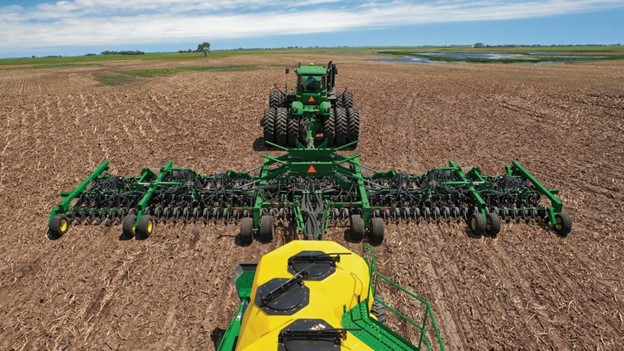USDA offered a number of surprises in their annual Prospective Plantings report, released on March 31. Nationally, the biggest surprise was in corn acres which USDA forecast at 89.5 million, down 4% from 2021 and the lowest in 5 years.
Despite a soybean-corn ratio that began the day at a low 2.24 to 1, which would typically favor corn, farmers opted for more beans in the survey. One would have to guess that the culprit was surely not price but had to be the sharply elevated input costs for corn versus beans. Illinois, Indiana and Iowa came in at 300,000 fewer acres, while North Dakota intends to seed about a half-million fewer acres than a year ago.
For the second part of the acreage intentions surprise, soybean acres were reported at a much-higher-than-expected 91 million acres, which, if it comes to fruition, would be record large. The 91 ma compared to the pre-report Dow Jones estimate of just 88.8 ma and last year’s 87.2 ma — up a whopping 3.8 million acres — nearly the polar opposite of corn.
The all-wheat acreage intentions number came in slightly lower than expected at 47.4 ma, with the trade expecting 47.8 ma. That was up from 46.7 ma a year ago, so 700,000 acres more. Buried in that total was intentions of 34.2 ma of winter wheat — about 200,000 acres fewer than expected, and 11.2 ma of spring wheat — down 500,000 from expectations.
Despite the increased planted acres year-over-year, if realized, the all-wheat planted area is the fifth-lowest since USDA began keeping records in 1919.
Winter wheat is up 600,000 acres from last year, with spring wheat acres down nearly 200,000 acres, sending Minneapolis to a strong close, while Chicago and Kansas City rebuffed higher prices, finishing lower. A fall of 500,000 acres in hard red spring wheat was a bit of a surprise and was likely due to soybeans. Durum wheat intentions were about 20,000 acres more than the trade estimated, at 1.92 ma, and up 17% from last year.
Farmers are now considering the profit potential of crops other than spring wheat. In fact, USDA’s survey shows farmers in the Northern Plains spring wheat and durum production area intend to plant 584,000 more acres of barley, dry peas, sunflowers, lentils and flax this year compared to 2021. That is what USDA expected based on the favorable prices of those alternative crops.
In Montana, total seeded crops for the 2022 growing season are expected to be up 6.5% at more than 8.5 million. All wheat acreage in Montana is expected to total 5.94 million acres for 2022. Winter wheat seeded last fall for harvest in 2022 is estimated at 2.05 million acres, up 100,000 acres from the 2021 crop. Growers intend to seed 840,000 acres of Durum wheat this year, up 170,000 acres from last year. Growers intend to seed 3.05 million acres of spring wheat this year, up 150,000 acres from last year. Growers intend to plant 1.05 million acres of barley in 2022, up 110,000 acres from last year’s actual plantings, and if realized, would be the largest barley planted acreage since 2003.
Montana canola producers intend to plant 170,000 acres in 2022, down 15,000 acres from the record high planted acreage set in 2021. Flaxseed producers intend to plant 110,000 acres in 2022, down 25,000 acres from last year. All chickpeas area planted is expected to total 140,000 acres, down 35,000 acres from 2021. The acreage of small chickpeas is expected to total 17,000 acres and the acreage of large chickpeas is expected to total 123,000 acres this year. Lentil acres planted for 2022 are expected to total 580,000 acres, up 50,000 acres from last year and the second highest planted acreage on record.
All dry edible pea area planted, which includes Austrian winter peas, is expected to total 600,000 acres, up 30,000 acres from last year and the second highest planted acreage on record.
Montana growers intend to plant 115,000 acres of corn for all purposes in 2022, down 5,000 acres, or 4 percent from last year’s plantings. The area expected to be seeded to oats, at 60,000 acres, is unchanged from a year ago.
The area planted to sugarbeets is expected to be down 700 acres from last year’s actual plantings to 43,000 acres. Hay producers in the state intend to harvest 2.45 million acres this year. This is up 160,000 acres from the acreage cut for hay in 2021.
There can be significant differences between the March Prospective Plantings, June Acreage, and final planted area of crops like spring wheat and durum. In addition to decisions about alternative crops, total planted area of spring wheat and durum will also be affected by the weather.
###
DTN/USDA-NASS/US Wheat


